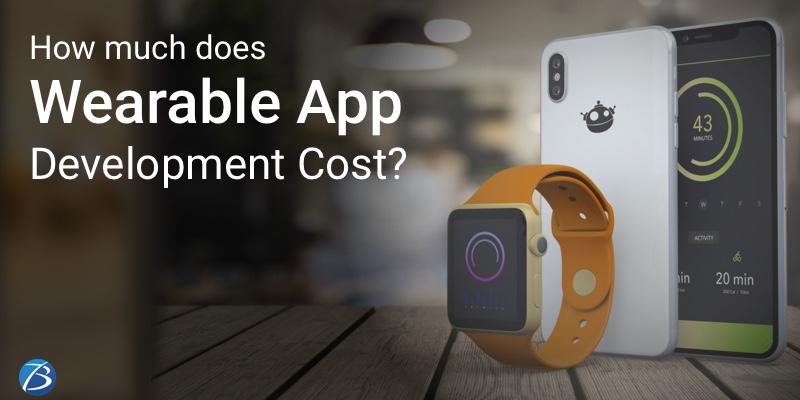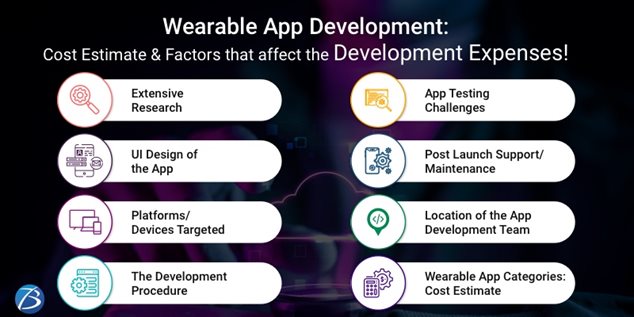How Much Does Wearable App Development Cost?
Get a rough estimate of the cost of developing wearable applications and learn about the factors that affect developmental expenses in this article.

Today, a huge chunk of tech-savvy individuals own fitness bands, smartwatches, and hands-free GPS systems. Such wearable devices are empowered with new-fangled sensors, microprocessors, and chips supported by robust operating systems. And, just like smartphones, modern wearables support various apps that can be used for syncing data from users’ devices.
Wearable technology has worked wonders to enhance the convenience quotient of modern-day individuals. Here are some instances!
.jpg?width=634&height=317)
Using Recordr, an Android wearable app, users can record sounds from their surroundings by simply tapping an icon placed on the right side of their smartwatches.
Spotify enables users to listen to uninterrupted music, scroll through the playlists, adjust the volume, etc. without having to use a smartphone.
Travelers can gather crucial information concerning cabs, buses, trains, ferries, etc. with the Citymapper app installed in their smartwatches.
No wonder, the popularity and demand of wearable apps are skyrocketing! As such, entrepreneurs are keen to build wearable apps. And, many of you would like to get a rough idea about the development expenses. So, I have penned down the factors that affect the wearable app cost and provided an estimate on the developmental expenses.
Factors Affecting the Wearable App Development Cost

Extensive Research
Researching about the market and user base for understanding the specific requirements of target users, is an essential practice. This activity helps the software company to clearly define the project scope, eliminates unwanted glitches during wearable application development, and ensures the creation of an impeccable application.
But, this research consumes a considerable amount of time and efforts. Most of the firms do charge for market research and this activity affects the price estimation of the project for sure.
UI Design of the App
The UI design of a wearable app is way different from that of an application developed for a tablet or mobile device. For example, a smartwatch needs to have four major interaction points – faces of the watch, voice commands, notifications, and independent wear native- based applications.
Watch Face: If the app is time-based, a watch-like look and feel need to be created.
Voice commands: Integrating the voice command feature within a wearable is trending these days. This feature enables users to use their voices for initiating commands. So, special attention and extra efforts are needed for crafting a voice-based user interface.
Notifications: Notifications display contextual and movable data, and deliver a seamless user experience. This feature helps users in replying to messages, searching for a location using a map, playing their favorite songs, and many more.
Wear Apps: These apps are likely to function without any smartphone connectivity. For building such independent applications, you may either follow a similar approach as in mobile app development or reinvent the wheel as per your specific needs.
Platforms/Devices Targeted
The kind of hardware devices and software platforms targeted affect wearable app costs to a great extent.
For instance, let’s compare the expenses involved for the Android and iOS platforms. Many of us are of the opinion that wearable development for the Android platform is less complex and involves lower costs. But, in reality, developing wearables for the iOS platform is speedier and more cost-efficient.
The reason is, Android OS powers a wide range of wearable devices. So, Android developers have to scale the app accordingly for providing support to varying screen sizes. And, the development costs for various screen sizes differ. Therefore, Android app development is costlier and time-consuming. Coming to iOS, it powers limited devices, resulting in lower development costs as well as faster time-to-market.
The Development Procedure
Wearable app development is slightly different from the standard mobile app development process. Android development involves fewer interactions, has access to standard Android APIs, and also leverages the APIs as well as features of a smartwatch.
iOS development, too, comes with its set of specific requirements that spikes the wearable app cost. The good news is that Apple has launched a new version namely watchOS 6 along with some APIs that will enable in delivering a robust UX; and features that support developing autonomous watch applications.
App Testing Challenges
The testing and maintenance costs are higher for wearable apps as compared to other mobile app categories. The reasons are as follows:
Screen size: Wearable apps target varying screen sizes and so, need to test the app’s performance on different sized screens.
Battery Life: The battery life of the primary device needs to be tested extensively. For this, different instances are to be considered. One instance involves switching off the primary device to check how the data gets affected.
Data Syncing: To test the data syncing between a mobile app and its connected wearable app one needs to watch out for various scenarios like what happens when one of the devices gets switched off, how does the app perform when the Bluetooth connection gets lost, and so on.
A Dearth of Emulators: There are a few emulators available in the market and this expedites the Wearable app cost.
Post Launch Support/Maintenance
Newly launched wearable apps are likely to encounter unexpected glitches, downtime, or software failures. Needless to say, it’s advisable to hire technical support/maintenance wearable app development services for keeping up an app’s performance standards, preventing downtime, and averting incidents of wearable app failure when the load is high.
These support services may be needed for multiple weeks post-app launch and incur additional expenses.
Location of the App Development Team
Wearable app cost is heavily dependent on the location of the app development center as the rates of hiring wearable app developers are not the same in every country/region. Take a look at the hourly rates for hiring developers from these regions:
India – between $10 and $75 per hour
Eastern European region – between $20 and $110 per hour
South American region – between $25 and $120 per hour
Australia – between $35 and $150 per hour
The UK – between $35 and $175 per hour
North America – between $20 and $250 per hour
So, your development cost revolves around the location of your outsourcing partner. Here, North America is the most expensive option and India is the most cost-efficient choice.
Wearable App Categories: Cost Estimate
Here’s a rough estimate of the expenses likely to be incurred for building a wearable app based on their categories. The average cost range of building the following categories of wearable apps are as follows:
A Fitness app like Fitbit – between $28,000 and $35,000
An app like Starbucks – between $70,000 and $100,000
A media-sharing app like Instagram – between $120,000 and $150,000
An app like Airbnb – between $140,000 and $200,000
An ecommerce app – between $200,000 and $250,000
Final Thoughts
I hope, my esteemed readers are now well versed in estimating the cost of their upcoming wearable app development project and have clearly understood the major factors that drive the wearable app cost.
For any technical assistance in tailoring wearable applications, Biz4Solutions, a distinguished software development company, will be worth a try! Our outsourcing software development services have proved beneficial to global clients for the past 10+ years.